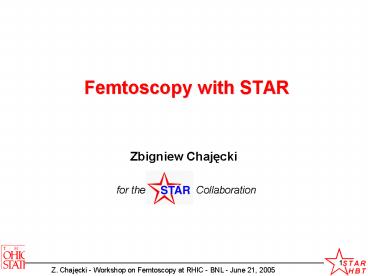Femtoscopy with STAR - PowerPoint PPT Presentation
Title:
Femtoscopy with STAR
Description:
important ingredient of Buda-Lund hydro picture (Csorgo et al.) t ... Worst-case picture of d Au. Not great fit ... Lopez-Noriega, nucl-ex/0505009 ... – PowerPoint PPT presentation
Number of Views:15
Avg rating:3.0/5.0
Title: Femtoscopy with STAR
1
Femtoscopy with STAR
- Zbigniew Chajecki
- for the Collaboration
2
Outline
- Probing space and time in Heavy Ion Collisions
with Femtoscopy - Evolution and emission time
- Size and shape of the source
- Do we understand the transverse mass dependence
of HBT radii? - Underlying physics in AA dynamically-driven
geometric substructure - AuAu relative to pp (and dAu)
- Problem with baseline of correlation function for
pp and dAu collisions - Decomposition of correlation function in terms of
spherical harmonics new approach of studying
particle correlations - Summary
3
The sketch of Heavy Ion Collision
hadronic phase and freeze-out
QGP and hydrodynamic expansion
hadronization
initial state
pre-equilibrium
Emission time
temperature
Evolution time
Chemical freeze out
Thermal freeze out
4
Hydro predictions Evolution and Emission time
- Long lifetime of the source
- as signal of the QGP formation
- Ro - Rs ? Emission time
- Rl ? Evolution time
- Hydrodynamic calculations reproduce momentum
observables but fail to reproduce HBT results ?
RHIC HBT puzzle
5
Origin of HBT puzzle
STAR - AuAu_at_200GeV, PRC 71 (2005) 044906
Modified Sinyukov fit to RL
M. Herrmann and G.F. Bertsch, PRC 51 (1995) 328
in the absence of transverse flow
Short emission time (2fm/c) consistent with
RO/RS ratio
6
Properties of the source at freeze-out
STAR, PRL93 012301 (2004)
STAR, PRL93 012301 (2004)
system changes the shape
system expands
eccentricity
- estimate ?initial from Glauber
- efinal from asHBT
- Size of homogeneity region scales with initial
source size (increase with increase of
centrality of the collision - b?0 ) - Oscillation phases out-of-plane extended
source
PRC66 (2002) 044903
Source remains out-of-plane at freeze out
7
Why do the HBT radii fall with increasing pT ?
- Decrease of HBT radii with pT
- usually attributed to collective flow
- RL ? longitudinal flow
- RT ? transverse flow
- Non-flow possibilities
- termally (not collectively) expanding source
- hot core surrounded by cool shell
- important ingredient of Buda-Lund hydro picture
(Csorgo et al.)
t
8
HBT in AuAu vs pp (dAu)
9
AuAu like superposition of pp?
- AuAu N(strings in pp) ?
- AuAu N(blast-waves) ?
- NO! that would generate local space-momentum
correlations but in AuAu we see global
correlations although both scenarios would
lead to the identical p-space observables
10
Initial vs Final Size pp(dAu) vs AuAu
- AuAu mostly understood in terms of collective
flow - pp (dAu) show apparent global space momentum
correlations, but no (or little) expansion - Model-dependent approach of
- veryfication of expansion scenario
- RMS of initial size of the source calculated with
Glauber model vs. experimental RSIDE for
ltkTgt0.2 GeV/c
11
Intriguing results ....Lets take a closer look
12
Projection of 3D CF in dAu
STAR preliminary
- Gaussian source vs non-Gaussianess of CF
- It looks like fit describes the shape of
correlation function
dAu central, kt 0.25-0.35 GeV/c
13
Worst-case picture of dAu
STAR preliminary
- Not great fit
- One imagines one could do a better job, but fit
must work in 3D we see tiny portion of space - What is going on in the normalization
region?(independent of Gaussian ansatz) - Problem with projections
- cannot see systematics in 3D
- experiments w/same CF will have different
projections
dAu peripheral, kt 0.15-0.60 GeV/c
14
Decomposition of CF onto spherical harmonics
Z.Ch., Gutierrez, Lisa, Lopez-Noriega,
nucl-ex/0505009
- Cartesian-space (out-side-long) naturally encodes
physics, but is poor/inefficient representation - Recognize symmetries of Q-space -- decompose by
spherical harmonics! - Direct connection to source shapes
Danielewicz,Pratt nucl-th/0501003
decomposition of CF on cartesian harmonics - immune to acceptance
- full information content at a glancethanks to
symmetries
? 0,2p ? 0,p
15
Some properties of Alm coefficients
- Alm 0 for l or m odd identical particle
correlations - (for non-id particles, odd l encodes shift
information) - A00(Q)































